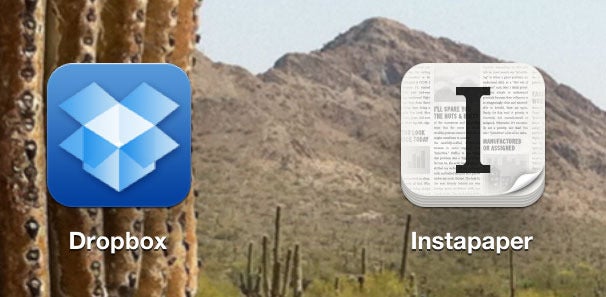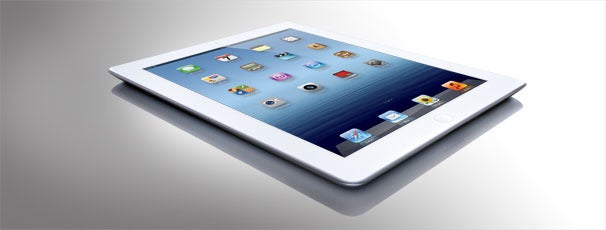
The iPad has been a remarkable success story. Apple sold 15 million of the original model in the first nine months of the product’s existence, a number that blew away even the most optimistic prognostications. With last year’s introduction of the iPad 2, things kept accelerating. In a little less than two years, Apple has sold roughly 60 million iPads, dominating the market it created.
Maintaining Apple’s lead in tablet devices is the job of the third-generation iPad, a product that doesn’t mess with success. Like the iPad 2 before it, this new iPad is not a re-thinking of the original concept. Instead, Apple has chosen to focus on a few areas of improvement while keeping the overall package the same. Though it’s an approach that can frustrate people who are disappointed by anything that’s not a quantum leap, Apple executes it to perfection and reaps the rewards.
In my review of the iPad 2, I suggested a rule of Apple product evolution I called “Jobs’s Law”—that the latest version of any Apple product is likely to be thinner and lighter than its predecessor. The third-generation iPad breaks that law. It’s actually slightly thicker and slightly heavier than the iPad 2, and in many cases users won’t perceive it to be faster.
But the changes Apple has wrought with this iPad aren’t about making it thinner or lighter or faster, but about making it better. And on nearly every front, the third-generation iPad is markedly better than its predecessor.
Video review
It’s all about the Retina
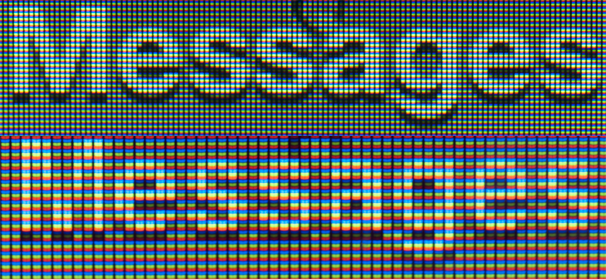
A photo comparing the new iPad's Retina display (top) to the iPad 2 display.
In mid-2010 with the release of the iPhone 4, Apple introduced us to a new concept—the “Retina display,” so called because the screen was packed tightly with so many pixels that the dots would be imperceptible to the human eye. At 326 pixels per inch, the iPhone 4 and its successor, the 4S, provide text that looks like it was printed on paper and display photos and videos in high definition.
Far and away the most important feature of the third-generation iPad is that it, too, has a Retina display. Its 9.7-inch screen has a resolution of 2048 by 1536 pixels (a total of four times the pixels in the same space), or 264 pixels per inch. Although that’s a lower pixel density than the iPhone’s Retina display, you tend to hold an iPad further away from your eyes than an iPhone, so the Retina definition still works out.
The result is similar to going from an early iPhone to an iPhone 4—it’s a big leap in quality. Text, video, and photos all benefit. Whether you’re reading a webpage in Safari, a long article in Instapaper, or an even longer work in iBooks, text is razor-sharp. Of course, the display on previous iPads was no slouch. But the moment you pick up a third-generation iPad, you can tell the difference. All the slight jagginess and oddly misshappen characters we take for granted on lower-resolution displays just vanish on the Retina display, and you’re left with the same sort of typographic excellence you’d expect in a printed book.
The effect is even more dramatic with photos and video. Pictures reveal small details that simply weren’t there before. A photo that looks just fine on an iPad 2 looks almost undefinably better on the new iPad. It’s the same image, but all of a sudden, there’s much more information there—small textures and tiny details that were previously omitted.
That’s also true with high-definition video. The third-generation iPad’s screen actually contains more pixels than an HDTV. As a result, the Videos app actually has to blow up 1080p videos slightly in order to display them across the full width of the its screen. (The screen of previous iPads didn’t have enough pixels to show a complete HD picture, so it had to either scale things down or cut off the sides of the frame.)
The videos look great. Watching an HD movie or TV show on the new iPad is like having a home theater in your lap. (Well, assuming you’ve got some good headphones, of course. The iPad’s mono speaker seems to be unchanged from the previous model.)
Buyers of this third-generation iPad will love the Retina display, but the fact is that the iPad 2's screen was also excellent. It may be that there just isn't quite as dramatic a contrast between the two screens as there was between the pre- and post-Retina iPhones two years ago. Maybe I’ve been spoiled by my iPhone’s Retina display, or maybe the iPad 2’s display is really that good.
I found the color temperature on the new iPad to be warmer and more yellow than that on the iPad 2. In isolation, both screens seemed perfectly normal. Only when I placed old and new iPads together did I notice that one is slightly warmer than the other.
As with the transition to Retina displays on the iPhone, app developers will need to step up to take advantage of the higher resolution offered by the new iPad’s display. Surely many (if not most) of them knew this day would come, but it’s quite a job for developers to create new, Retina-sized versions of every graphic in their apps, and it may be some time before all iPad apps are updated. (Non-Retina apps look more or less like they did on previous iPads—but on the new iPad’s Retina display those pixels really stand out.)
Still, it’s not all bad news. Text in most apps will take advantage of the Retina display without modification, even if the graphics don’t. There are odd exceptions, however. When I tested Amazon’s Kindle app with the new iPad, I found that its text was pixelated, not Retina-crisp. Presumably Amazon will fix this in an update. I saw some weird behaviors in a few existing apps, but most of them worked just fine even without being updated. And some work better than you’d think—I tried Comixology’s Comics app and discovered that there’s more resolution to those digital comics than I had realized.
If you’re running an iPhone app on the new iPad, it will display it in high-resolution Retina detail—but in a small compatibility window in the center of the iPad screen. (You can, as always, tap a 2x button to make iPhone apps bigger but more pixelated.)
More power? Sort of.
The iPad 2 was much faster than the original iPad, thanks to its dual-core A5 processor. But the A5X processor that powers the third-generation iPad doesn’t really offer more processing power than its predecessor. In all our processor-based tests, the new iPad ran about as fast as the iPad 2. (Which is not to say it’s slow—they’re the two fastest iOS devices ever.)
With this update, Apple wasn’t as concerned about boosting the iPad’s speed even further, because it had another, bigger problem to solve: Boosting the iPad’s graphics capabilities so that it could update the 3.1 million pixels on its Retina display. (Keep in mind, previous iPad screens only had about 786,000 pixels.) Updating that many pixels requires a whole lot more graphics power just to keep things running as smoothly as before.
That power comes from the X factor in the A5X processor—a new quad-core graphics engine. And sure enough, the third-generation iPad blows away every other iOS device in terms of graphics performance. In our tests using the GLBench 3D graphics testing app, the third-generation iPad could draw a complex 3D scene at the full frame rate of its display, 60 frames per second, without breaking a sweat. And in GLBench offscreen tests, which aren’t constrained by the display’s refresh rate, the third-generation iPad had a frame rate 1.6 times that of the iPad 2 (and 13 times that of the original iPad).
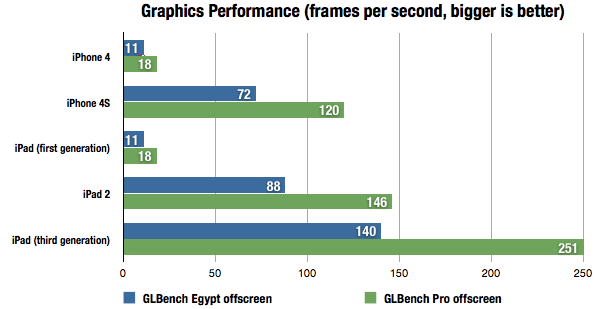
So the new iPad definitely has the horsepower to render high-quality graphics on its Retina display. However, app developers will need to update their apps to work well on the new iPad. All of Apple’s built-in apps worked well with the Retina display, scrolling smoothly at all times. But several third-party apps had glitches, including unresponsive interfaces and stuttering scrolling.
What this suggests is that developers who could get away with some inefficiencies when painting the relatively small canvas of previous iPad screens will find those inefficiencies laid bare when they first run their apps on this new hardware. Apple’s apps show that the new iPad has the power to keep it all smooth; but it looks like app developers will need to run their apps on this new hardware and then spend some time optimizing their code so that it shines on this new, bigger display.
Going beyond pure graphics performance, my tests found the new iPad to be roughly the same speed as the old one. The GeekBench testing app said the iPad 2 was slightly faster. The Sunspider JavaScript benchmark gave them both the same scores. And in my webpage-loading test, the new iPad was faster.

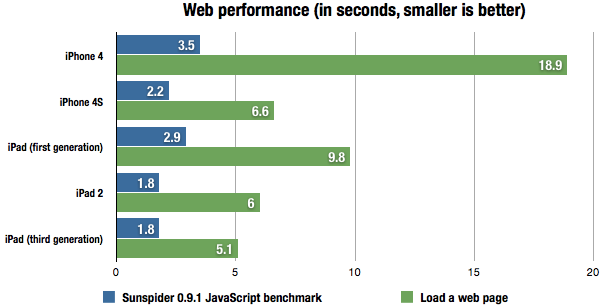
Dead ringers
Usually when I review a new Apple product, I start with the physical changes. People always want to know how the new thing is different from the old thing. But the third-generation iPad is almost physically identical to the iPad 2. You can’t tell them apart unless you look very closely.
The differences I’ve noticed: The inside of the dock connector is silver and not black, and the rear camera is a little bit bigger. Yeah. That’s it.
Almost imperceptible is the fact that the new iPad is a bit thicker than its predecessor. The iPad 2 was 8.8 millimeters thick, and the third-generation model is 9.4 millimeters thick. So there’s an extra six tenths of a millimeter there now, I suppose, but it was imperceptible to me. (The original iPad was 13 millimeters thick—now that’s a difference you could feel.)
The new iPad is also heavier than the iPad 2. The new model weighs either 652 grams (1.44 pounds) for the Wi-Fi-only model or 662 grams (1.46 pounds) for the 4G model. In contrast, the Wi-Fi iPad 2 weighed 601 grams (1.33 pounds) while the 3G model of the 3G-equipped iPad 2 was 613 grams (1.35 pounds). So your standard Wi-Fi iPad has put on about 50 grams or a tenth of a pound. It’s a small weight gain, but I can’t call it imperceptible. The first time I picked up the third-generation iPad, I could tell that it was heavier.
What does this increased weight mean in practice? Probably not very much. Even the iPad 2 is not a product that you can just hold indefinitely with one hand. It’s too heavy and too bulky for that. This is a device that’s best when held in two hands or propped against your lap. The iPad 2 was easier to hold than the original iPad, and the new iPad feels pretty much the same on that score. The extra tenth of a pound may be noticeable, but I don’t think it’s meaningful.
The 2011 and 2012 iPad vintages are so alike, in fact, that they can use the same Smart Covers. And all but the most exacting iPad 2 cases will probably work on the third-generation model. I tried the new iPad with a few assorted iPad 2 cases hanging around our offices and it fit in all of them just fine.
Now, the big question is: Why this deviation from Jobs’s Law? Isn’t every new Apple product supposed to be smaller, thinner, and lighter? I do believe that’s Apple’s ultimate goal. But in this case, it’s clear that the boosted graphics processor, the support for 4G networking, and the high-resolution display and its corresponding LED backlights, all add up to a device that requires a lot more power than the iPad 2 did. And so Apple did what it had to do in order to keep that famous 10-hour iPad battery life: It made room for a bigger battery at the cost of size and weight.
According to Apple’s tech specs page, the new iPad has a 42.5 watt-hour battery. Compare that with the iPad 2’s 25 watt-hour battery. That’s a whole lot more battery just to keep the iPad running for the usual amount of time. Apple wasn’t willing to trade away battery life for thinness and lightness, so here we are: with a new iPad that’s imperceptibly thicker and immaterially heavier. It’ll do.
I wasn’t able to do extensive battery testing, but in my use over the past week I’ve found that Apple’s claims of comparable life to the iPad 2 are accurate. I can get through an entire day using my iPad and I don’t run out of juice. I suspect that this new battery will take longer to charge than previous models, though—so prepare for an overnight recharge in order to completely juice up your battery.
Picture perfect
The original iPad didn’t have cameras. The iPad 2 added a low-resolution, front-facing camera for video chat and a rear camera with just enough resolution to shoot 720p video. That rear camera was, to put it bluntly, not very good. It was the weakest feature of the iPad 2, in fact.
The good news is, with the third-generation iPad, Apple has finally righted this wrong. Apple’s dusted off an old brand name (just as it did when the old iBook laptop became the new iBooks app) and applied it as a label to that camera: iSight. iSight, apparently, means “camera good enough to shoot photos and videos with.” And it is. It’s a five-megapixel camera, not quite on a par with the one in the iPhone 4S, but still quite good.
When I compared images from the new iPad’s iSight camera against test images taken by other mobile devices, I found that the new iPad’s camera fared quite well. It offered roughly the same image quality as the iPhone 4S and the Asus Transformer Prime, and clearly outdistanced both the Samsung Galaxy 10.1 and the iPad 2. It seems safe to say that the new iPad has the best camera of any tablet device, and among the best of any mobile device. Most notably, the quality of the 1080p video I shot with the new iPad was very good, even in low light.

Portions of full-resolution images from three different Apple devices.
The iPad’s sheer size doesn’t make it an ideal camera, but if you do need to shoot something and your iPad is at hand, the third-generation iPad’s camera is of a high enough quality that you won’t regret your choice.
Takes dictation, but not orders

I actually find Siri useful in many cases where speaking a brief command is more efficient than swiping to unlock, swiping to find the right app, and then tapping through an interface in order to get what I want. I use Siri to set alarms and timers all the time. I don’t see why that wouldn’t be relevant on the iPad. (Of course, those features use the iPhone’s Clock app, which Apple also omits from the iPad! And one of Siri’s other marquee features, getting a weather forecast, uses the Weather app—another iPad no-show. Sigh.)
That said, dictation is still a great feature and I’m happy to have it on the iPad. Yes, there have been apps available that allow you to dictate, but now you can dictate from the standard software keyboard just by tapping the new microphone icon, and that’s a big deal. Once you get the hang of dictation, which requires you to speak all your punctuation comma you’ll discover that it can be a great way to input text without typing period
LTE and cellular options (in the United States)

Ever since the original iPad debuted, Apple has offered two different models with different networking features. The base-priced models support only Wi-Fi, but for £100 more you can get a model with support for both Wi-Fi and cellular networking. The cellular features don’t require any sort of contract; instead, you can buy access right on the device, a month at a time, and activate and deactivate whenever you want.
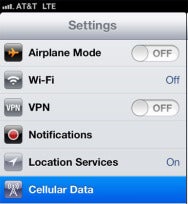
When rumours surfaced that the iPad 3 would have LTE (long-term evolution) networking, there was surprise. LTE is thought of on phones as a battery killer, because it demands so many radio frequencies at once. This is where that upsized battery comes in. But the implication seems to be that much of that is upped in order to drive the pixels, rather than for LTE. Apple says that using LTE will only reduce the battery life by one hour, from ten hours to nine.
I didn't get any chance to test the 4G/LTE connectivity, and it's unlikely anyone in Europe will be able to. The US, for which the 4G iPad is designed, uses 700MHz spectrum for LTE; but in the UK we're on 800MHz, and other countries have similar incompatibilities. Equally, we're not really expecting 4G/LTE to be widespread until late 2013 at least, which is at least one more generation of iPads away. That gives Apple the chance to introduce a "European" 4G iPad, if it thinks it's worth it. But for the most part, European buyers – unless they're going to travel to the US – should expect that the LTE circuits will stay dark.
However there is HSPA (high speed packet access) and DC-HSPA (dual-cell HSPA) connectivity, which some networks in the UK are rolling out. Those offer faster connections than 3G – and faster than the average fixed broadband too – so Orange/T-Mobile is happy to describe it as "3.5G". It'll do. The key thing is that it's faster, and it isn't going to put a dent in your battery life. And 3G will work. So again, it's a feature you'll get little use out of – but as the price is the same as a year ago, you're getting the screen for free.

Tests by Jason Snell using the Ookla Speedtest iOS app.
At long last, the iPhone’s Personal Hotspot feature has come to the iPad. This is great news, because it means your iPad can act as a Wi-Fi router and provide an Internet connection to any device that uses Wi-Fi by relaying data from its cellular connection. Unfortunately, it appears that only Verizon is supporting this feature at first, with AT&T lagging behind. The third-generation iPad I used was of the AT&T variety, so I wasn’t able to test this feature. But it promises to be pretty cool, since if you’ve got one of these iPads you don’t need to invest in a separate piece of Wi-Fi routing hardware.
AT&T has a track record as an unenthusiastic supporter of tethering features. It took the company a full year to activate tethering on the iPhone. As a result, I’d recommend the Verizon model if Personal Hotspot is a must-have feature. And I’m impressed with Verizon’s approach to Personal Hotspot on the iPad: It doesn’t cost any more. You pay for the amount of data you want your iPad to consume, and if you want to share that data pool with other devices, Verizon’s fine with that.
Buying options
For a company that likes to keep things simple, Apple has provided us with a whole bunch of options when it comes to buying the iPad. Just as with the iPad 2, the third-generation model comes in 18 different varieties. You can choose from:
- 16GB (£399), 32GB (£479), or 64GB (£559) of onboard storage
- White or black bezel (no price difference)
- Wi-Fi only, or Wi-Fi plus cellular (£100 extra)
In the past, I’ve told most people that 16GB is plenty of storage for most iPad users. But 16GB isn’t what it used to be. Apps updated to contain Retina-level graphics will balloon in size. HD video files are enormous. Those iBooks enhanced textbooks can be enormous. And shooting five-megapixel images and 1080p video will fill any remaining storage in a hurry.
I still think most buyers should start with the assumption that they’ll only need 16GB, but then they’ll need to ask themselves a few questions. Anyone who intends to load up with lots of HD movies, shoot videos, or install a whole lot of apps should seriously consider a larger capacity. But a lot of people just don’t use the iPad like that, and for them, 16GB will be fine.
Then there’s the question of whether to spend an extra £100 for cellular networking. With the addition of Personal Hotspot, the cellular iPad has become more appealing. Given that the iPad’s data plan features no contracts—so you can turn it off and on at will—it’s a more flexible option for Wi-Fi tethering than either adding tethering to a cell phone plan or buying a separate Wi-Fi hotspot device such as a MiFi.
If you can see using your iPad as a personal hotspot or envision using it often when you’re out of Wi-Fi range, the extra £100 is probably a good investment. However, lots of people almost never use their iPads out of range of Wi-Fi, so I expect the Wi-Fi version will remain the most popular option.
One last reason to consider buying a cellular-capable iPad: Only cellular models come with GPS capabilities. There’s a good reason for this—iOS devices use assisted GPS to dramatically decrease the amount of time it takes for the devices to determine their location. If you dream of using your iPad as a jumbo GPS navigation console, you’ll absolutely need to pay the extra £100.
The iPad experience
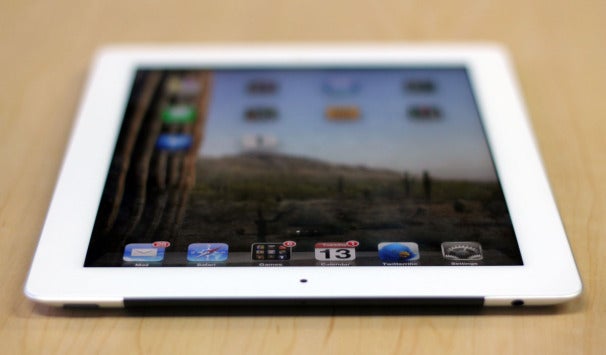
When it’s time to ponder a new Apple product, it’s easy to get caught up in the details of the specs, in what’s changed from previous versions. With a product like the iPad, that’s a dangerous game. Apple’s decision to avoid calling the new iPad an iPad 3 or iPad HD or iPad 2S speaks volumes. The iPad is bigger than any single model.
Clearly, Apple’s vision is that we’re in a period where many tasks we previously performed with computers will be transferred to new, different, less computery devices. The iPad, like its brother the iPhone, is ushering in a new world. Microsoft spent a decade trying to define the “tablet computer.” Apple dropped the computer, from both its company name and the tablet category, and has seen massive success. Even now, the “tablet market” is really the iPad market, and the onslaught of iPad competitors we all expected two years ago has largely failed to materialise.
After Apple’s launch event was over, I talked to several colleagues who cover Android every day, and they largely agreed with Cook’s point. There just aren’t very many good tablet apps on Android, and there doesn’t seem to be a lot of urgency to create them.Yes, one of the reasons for the iPad’s success has been that Apple started with a huge lead on its competition. But the biggest reason the iPad is so strong was one quite rightly pointed out by Apple CEO Tim Cook when he unveiled the new iPad: Apple’s advantage in apps. More specifically, iOS developers have worked hard to create versions of their apps that are designed for the iPad’s larger screen. Google, meanwhile, seems to view the larger canvas of a tablet screen as indistinguishable from a smartphone’s screen.
When the iPad was introduced, a lot of pundits sniffed that it was just a big iPod touch. And if that had turned out to be the case, the iPad wouldn’t have been very successful. But from the first day the iPad shipped, it’s had a huge amount of software designed specifically for its 9.7-inch screen. In the meantime, the competition ships big phones and hopes they’ll take the world by storm. It’s not happening.
Instead, the iPad’s sales continues to accelerate. And that’s one reason why I’m uneasy about focusing too much on the details of the differences between the third-generation iPad and its predecessors. I’d wager, in fact, that more third-generation iPads will be sold to people who have never before owned an iPad than to existing iPad owners who are upgrading.
Those are the people for whom this new iPad is simply called “iPad.” And they’ll use it for all the things that an iPad is great for. They’ll surf the Web, check email and Twitter and Facebook, read books and magazines, play games, watch movies, listen to a baseball game, look up a recipe, check their schedule, edit a photo or a video, record a song, or even write an essay.
When I’m looking for the perspective of someone who uses technology but doesn’t get overly excited by it, I turn to my partner. Her role in our family—and I suspect, dear reader, that you may find this familiar—is to provide a counterbalance to my enthusiasm over every new gadget I want to buy.
When the first iPad came out, I bought one. My partner seemed interested in it, and I was curious what she’d make of it, so I handed it to her and told her to try it out. She never gave it back. Recently, as we discussed buying her a new iPad, she told me that she only turns on the iMac we keep at home for managing photos, typing out long documents, and visiting the ever-decreasing number of websites that don’t play well with Safari.
That iMac, which was in heavy use two years ago, is now a device we turn on to perform specific tasks. The rest of the time we’re on our iPads or our iPhones, and it seems natural. This, I think, explains Apple’s confidence in where we’re headed in this post-PC universe.
In the old days, we used to talk about “computing,” as if it were an activity. Using a computer was computing. Computing didn’t go away. It just seeped into every aspect of our lives. Computing doesn’t happen on a desk anymore. It’s in our laps, in our pockets, perched on the kitchen counter or smack in the middle of the coffee table. The iPad didn’t make computing obsolete. It just brought it out of its shell.
Central IT’s buying advice
The new iPad is just that: The iPad, updated for a new year and millions of new iPad users. It's not smaller or lighter, but it's got a remarkable screen, a much better rear camera, and support for cellular networking that can run at Wi-Fi speeds. It's the iPad that millions of people have embraced, only one year better.
Users of the iPad 2 shouldn't fret: Their iPad investment is certainly good for another year. But they might not want to look too closely at the new iPad's screen. Once you get a load of that Retina display, it's hard to go back to anything else.


